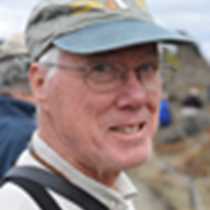Port Lockroy and Dalmann Bay, Antarctica
To be the captain of an expedition vessel in the Antarctic requires an impressive combination of skill and experience – the skill to handle a boat under varying conditions of wind and weather, the experience to judge the ice and make appropriate decisions of navigation - to challenge the ice head-on or turn aside to seek a safer passage. Today it all came together for our Captain Oliver Kreuss as he boldly set forth in his craft, accepting responsibility for the propulsion, navigation and safety of those on board.
We were at Port Lockroy, set into a well-protected cove on Wienke Island. It was discovered by the French explorer Jean-Baptiste Charcot in 1903 and used by whalers in the second decade of the 20th Century. Today the bones of great whales, stripped of their blubber for oil, litter the bottom of the shallow bay and adjacent shoreline. Some of the bones have been laid out in anatomical position, giving us an opportunity to appreciate the great size of these leviathans and their wondrous adaptation to marine life. In 1944 Port Lockroy became the site of a British base and southern listening post. The station on tiny Goudier Island was abandoned and falling into ruin until it was acquired by the Antarctic Heritage Trust. They have done a wonderful job of restoring it as a museum to give us a window into the lives of British “Antarcticians” in the 1940s and 1950s.
We left Port Lockroy and turned to the north towards our destination of Ushuaia, but by no means were we done. We passed through Dallmann Bay, hoping to find humpback whales. We did. Our first encounter was with a cow/calf pair. They were busy feeding, making shallow dives to a krill layer near the surface (as identified by our ship’s sonar), returning briefly to the surface to breathe, and then repeating the process … over and over again. Necessary for the whales, but not too interesting to watch. We were just turning away when our Captain burst out: “a breach!” He had spotted the splash of a breaching whale returning to the water. It continued the behavior, seemingly oblivious to our approach. It stopped to wave its giant pectoral fins in the air, slapping the water with loud smacks, and then it resumed breaching. Each display of aerial acrobatics was preceded by a fluke-up dive. Then, after a few seconds, the whale burst straight out of the water, revealing almost its entire body, before rolling over in the air and returning with a mighty splash. We counted thirty-five breaches in close succession and the whale was still breaching as we, reluctantly, bid our farewell, ate another fine meal, and entered the Drake Passage. Our visit to the region of the Antarctic Peninsula began with an encounter with large numbers of fin whales in the southern Drake, and concluded with this remarkable moment spent in the company of a breaching humpback.
To be the captain of an expedition vessel in the Antarctic requires an impressive combination of skill and experience – the skill to handle a boat under varying conditions of wind and weather, the experience to judge the ice and make appropriate decisions of navigation - to challenge the ice head-on or turn aside to seek a safer passage. Today it all came together for our Captain Oliver Kreuss as he boldly set forth in his craft, accepting responsibility for the propulsion, navigation and safety of those on board.
We were at Port Lockroy, set into a well-protected cove on Wienke Island. It was discovered by the French explorer Jean-Baptiste Charcot in 1903 and used by whalers in the second decade of the 20th Century. Today the bones of great whales, stripped of their blubber for oil, litter the bottom of the shallow bay and adjacent shoreline. Some of the bones have been laid out in anatomical position, giving us an opportunity to appreciate the great size of these leviathans and their wondrous adaptation to marine life. In 1944 Port Lockroy became the site of a British base and southern listening post. The station on tiny Goudier Island was abandoned and falling into ruin until it was acquired by the Antarctic Heritage Trust. They have done a wonderful job of restoring it as a museum to give us a window into the lives of British “Antarcticians” in the 1940s and 1950s.
We left Port Lockroy and turned to the north towards our destination of Ushuaia, but by no means were we done. We passed through Dallmann Bay, hoping to find humpback whales. We did. Our first encounter was with a cow/calf pair. They were busy feeding, making shallow dives to a krill layer near the surface (as identified by our ship’s sonar), returning briefly to the surface to breathe, and then repeating the process … over and over again. Necessary for the whales, but not too interesting to watch. We were just turning away when our Captain burst out: “a breach!” He had spotted the splash of a breaching whale returning to the water. It continued the behavior, seemingly oblivious to our approach. It stopped to wave its giant pectoral fins in the air, slapping the water with loud smacks, and then it resumed breaching. Each display of aerial acrobatics was preceded by a fluke-up dive. Then, after a few seconds, the whale burst straight out of the water, revealing almost its entire body, before rolling over in the air and returning with a mighty splash. We counted thirty-five breaches in close succession and the whale was still breaching as we, reluctantly, bid our farewell, ate another fine meal, and entered the Drake Passage. Our visit to the region of the Antarctic Peninsula began with an encounter with large numbers of fin whales in the southern Drake, and concluded with this remarkable moment spent in the company of a breaching humpback.




